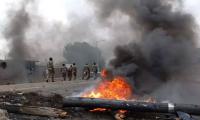The recent collision between a Rawalpindi-bound passenger bus and a private car on the Karakoram Highway (KKH) near Shatial in Gilgit-Baltistan (GB) – which resulted in 25 deaths and multiple injuries – serves as a grim reminder of the gross disregard for road safety and security standards.
The tragedy highlights the failure of the government to regulate public transportation and enforce road safety measures. The use of outdated vehicles driven by inexperienced drivers has turned public transport and rental cars into potential death traps on the KKH. The frequency of fatal road accidents and tragedies on this highway – resulting in the loss of more than a hundred lives each year – has become all too common. The lack of road security measures also leaves commuters at the mercy of poorly paid and untrained drivers, or of robbers and murderers.
Also, the absence of a comprehensive system to assess the fitness of vehicles and drivers for long journeys on the Gilgit-Rawalpindi route only exacerbates the situation. Instead of implementing essential road safety and security measures – such as modernizing the driving licence regime and improving the vehicle fitness review system – authorities in GB have opted for superficial measures, such as banning the transportation company. This approach falls short of addressing the root causes of the increasing fatalities on the KKH.
In light of these concerning developments, it is crucial that the government of Gilgit-Baltistan take immediate action to adopt the best practices in road safety and security from the international arena. This requires a comprehensive approach that addresses the systemic reforms necessary to prevent further loss of life on this deadly highway.
The importance of road safety and security cannot be overstated, particularly in a world where the number of vehicles on the road continues to increase. To reduce the devastating consequences of road traffic accidents, including fatalities, injuries and crashes, the international community has introduced a number of the best practices and standards.
One such initiative is the United Nations Global Plan for the Decade of Action for Road Safety 2011-2020, which outlines a comprehensive approach to improving road safety globally. This plan sets targets for reducing the number of deaths and injuries on the roads and serves as a blueprint for action to be taken by governments and other stakeholders.
Another important standard is the ISO 39001:2012 Road Traffic Safety (RTS) Management Systems. It provides a systematic approach to managing road safety and covers a range of key issues, including road safety policy, risk management, safety performance measurement, and continuous improvement.
The Vienna Convention on Road Traffic is another significant initiative, aimed at ensuring the safety of road users by setting out rules for international road traffic. This convention includes provisions on road signs, signals, and markings, as well as rules for the use of vehicles on international roads, and is an important tool for ensuring road safety in a rapidly changing and increasingly globalized world.
The European Agreement on Main International Traffic Arteries (AGR) is a further example of an international road safety and security standard, setting out common standards for the construction and maintenance of international roads in Europe. This agreement covers a range of important issues, including road safety, environmental protection, and sustainable transport, and is essential for ensuring that international roads are safe and sustainable for all users.
Finally, the World Health Organization (WHO) Global Status Report on Road Safety provides an annual update on the status of road safety globally, including data on road traffic deaths and injuries, as well as information on the implementation of road safety policies and interventions. This report is a critical tool for monitoring progress and assessing the effectiveness of road safety initiatives globally.
These international road safety and security standards play a crucial role in promoting safe and sustainable mobility and are essential for reducing the human and economic toll of road traffic accidents.
But what can the government do to develop a compressive safety and security system for the KKH in light of international best practices? The highway, which connects Pakistan and China, traverses through some of the harshest and most remote areas of the world, and represents a formidable challenge in terms of road safety and security. The highway’s remote location and inadequate modern infrastructure pose significant obstacles to accessing emergency services.
As the first logical step to address this, the government must establish a network of well-equipped rescue teams along the highway, equipped with vehicles, communication equipment, and medical supplies to swiftly respond to emergencies. GB authorities must install signboards along the road to provide travellers and drivers with essential information regarding road conditions, hazards, land-sliding zones and rest areas.
The harsh weather conditions of the Karakoram region pose an additional risk to travellers, with heavy snowfall, avalanches, and landslides being common in winter. To combat this, the government must institute a comprehensive winter maintenance programme, including snowploughs, road-clearing equipment, and weather monitoring systems to ensure that the road remains passable even during the most inclement conditions.
The government must take proactive measures to guarantee the security of travellers on the KKH, in addition to implementing road safety measures. Despite the region’s mountainous terrain offering a certain level of protection against potential dangers, it remains susceptible to criminal activities such as theft, robbery, and violent incidents. To counteract this vulnerability, the government should establish a dedicated highway security unit to be deployed along the KKH. This unit should have a strong presence and be equipped to respond promptly to any incidents that may occur.
A comprehensive regulatory framework must also be put in place to govern the issuance of driving licenses and ensure the fitness of vehicles and drivers. The fitness examination and periodic review process must be stringent and rigorous. It is imperative that long-route drivers receive a fair wage, which will motivate them to perform their duties with due care and attention.
There are several best practices from other mountainous regions around the world that can be adopted to improve the safety and security of the Karakoram Highway. For instance, regular road condition inspections, the installation of safety systems such as guardrails and cable barriers, and the deployment of rescue teams to handle emergencies can all make a significant impact.
By adopting these measures, the government can effectively address the unique challenges posed by the KKH and provide travellers with a safer and more secure journey.
The writer is a social development and policy adviser, and a freelance
columnist based in Islamabad. He tweets @AmirHussain76 and can be reached at: ahnihal@yahoo.com
Postman argues that “typographic mind” was yielding to “televisual mind”
Pakistan is well poised to meet opportunities that Artificial Intelligence will offer for developments in industries
Smog isn’t merely 'environmental' issue anymore, it is public health emergency, socioeconomic burden
As it evolves into Next Generation Air Force, PAF draws strength from its rich history and lessons learned from past...
Local govts of Punjab and WASAs as service delivery agencies are responsible for planning, providing services
Survey conducted in prisons highlights distinct patterns of crime shaped by socio-economic and demographic factors







